We know that the role of software testing in the software development life cycle (SDLC) is crucial and obligatory. Being an integral aspect of SDLC, software testing helps organizations and companies to develop and deliver error-free and high-quality software products that are in accordance with the customers’ specifications.
In order for software testing to be successful and complete, verification and validation play a critical role. It is commonly referred to as the V&V process, which ensures that the software product complies with the end users’ requirements and operates as expected in the real world. Verification and validation are two distinct procedures in software testing, even though they are often termed together.
Verification entails evaluating the software without running any of the source code, often known as static testing. On the other hand, validation, commonly known as dynamic testing, is the process of testing the software product with the help of the execution of its source code.
In this blog post, we shall focus on introducing you to static testing or verification and its various aspects.
What is Static Testing?
It is a kind of software testing approach performed to assess the software product with the intent to uncover defects or bugs without executing its source code. Instead of executing the source code of the software product, this type of testing emphasizes checking code and designing requirements and documents. It begins at the very first stage of the software development life cycle (SDLC), i.e., right from the requirements gathering and analysis phase.
The primary purpose of this type of testing is to avoid errors or bugs in the later stages of development that may need a significant amount of time, effort, and money to fix. As it identifies errors or bugs in the documentation stage, it is cost-effective and time-saving.
With static testing, it becomes easy to find the sources of bugs or failures and fix them immediately. It comes in handy to detect bugs that would not have been possible with dynamic testing or validation.
Objectives of Static Testing
Let us shed light on the objectives or goals of verification.
- Reduce the number of bugs in the software.
- Detect, analyze, and fix bugs or errors in the early stages.
- Save time, cost, and effort.
Why Perform Static Testing?
The following are some significant reasons that specify why the software product should undergo verification:
- Detects and corrects defects or errors in the software products at the early stages of SDLC.
- Minimizes the time and money spent fixing problems or mistakes in later phases of development.
- Boosts the productivity of the software development process .
- Reduces the development timescales.
- Results in a fewer number of defects in the later stages of SDLC.
What Different Features Can We Test in Static Testing?
Some of the most prevalent but important characteristics that we can validate during the verification process include the following:
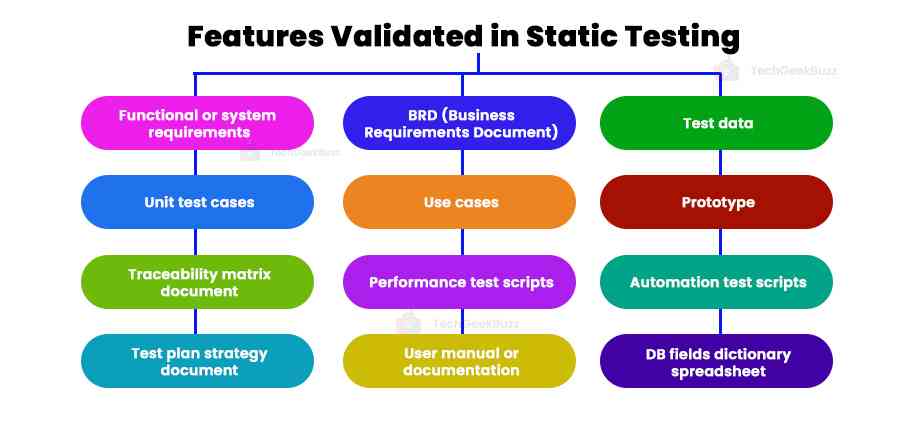
- Functional or system requirements
- BRD (Business Requirements Document)
- Test data
- Unit test cases
- Use cases
- Prototype
- Prototype specification document
- Traceability matrix document
- Performance test scripts
- Automation test scripts
- Test plan strategy document
- User manual or documentation
- DB fields dictionary spreadsheet
What Bugs Can Static Testing Detect?
The following are the kinds of defects that static testing makes easier to identify:
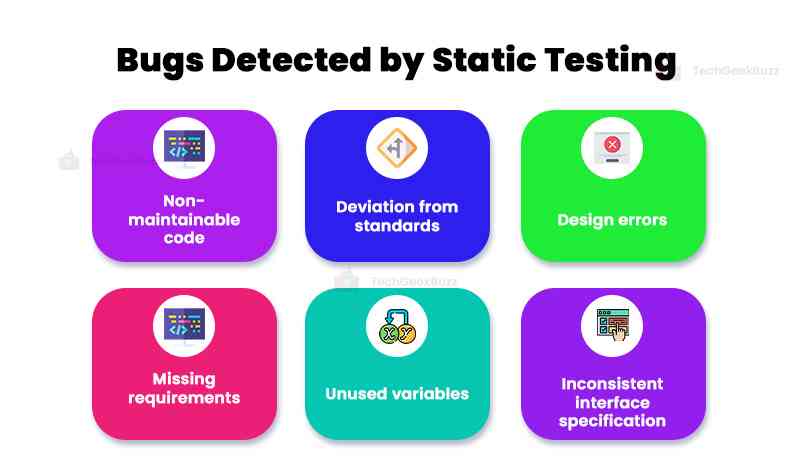
- Non-maintainable code
- Deviation from standards
- Design errors
- Missing requirements
- Unused variables
- Inconsistent interface specification
Any defect you uncover during this type of testing is the result of boundary violations, undeclared variables, syntax violations, security vulnerabilities, and inconsistent interface.
Static Testing Techniques
This type of testing can be carried out using two different techniques, namely review and static analysis. Let us delve deep into these two verification techniques.
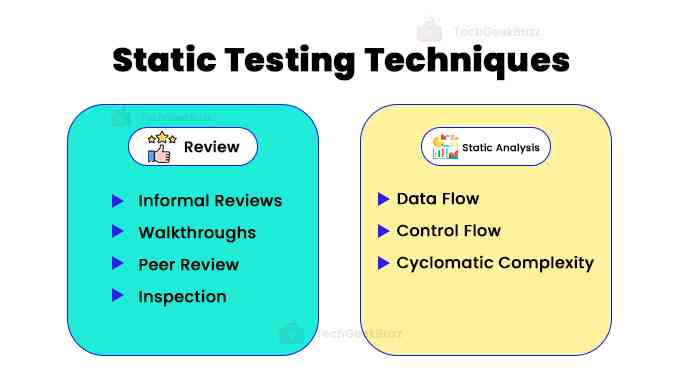
1. Review
Review is a static testing technique for uncovering potential errors or bugs in the design of the software product. This technique also involves identifying and correcting errors in various supporting documents, for example, software requirements specifications (SRS). In short, we can say that review in verification helps all the team members to know about the progress of the software product.
Further, there are four different types of reviews as follows:
-
Informal Reviews
In this type of review, the designer of documents places the content in front of the target audience and collects their feedback or views on it. The views or feedback are generally bugs or errors they find in the documents. As all this is done in an informal way, it is referred to as an informal review.
-
Walkthroughs
A skilled professional or expert carries out the walkthrough review to verify that the software product has no defects and meets the quality standards so that there would not be any problems in the further stages of development.
-
Peer Review
In a peer review, the designers of documents check each other's work to detect errors or bugs. This type of review takes place in a team of colleagues.
-
Inspection
Inspection involves verification of high authority documents, like software requirements specification (SRS).
Types of Participants in the Review Process
The following are the different types of participants involved in the review process:
-
- Moderator: A person who is responsible for performing the entry check, scheduling meetings, mentoring team members, and following up on rework is a moderator.
- Author: An author is a person with a responsibility to fix defects found in the documents and enhance the documents’ quality.
- Reviewer: A person who validates material for defects is a reviewer.
- Scribe: A professional in charge of logging defects during a review and attending the review meetings.
- Manager: A manager is responsible for determining the execution of reviews and verifying whether the review process goals are met or not.
2. Static Analysis
Another technique in static testing is static analysis. It entails the assessment of the source code written by developers to check its quality. A plethora of tools is out there that assist in analyzing and evaluating the source code. Alternatively, we can say static analysis helps identify structural bugs in the source code by analyzing it, which may further develop into potential defects.
With static analysis, you can detect the following defects:
- Unused variables
- Dead code
- Infinite loops
- Wrong syntax
- Variables with undefined values
The static analysis consists of the following three types:
- Data Flow: It is associated with the stream processing
- Control Flow: It determines how the instructions or statements should be executed.
- Cyclomatic Complexity: It is a complexity metric that measures a program’s complexity, where the program is associated with the number of independent paths in its control flow graph.
Static Analysis Tools
As mentioned above, there are a lot of tools available that aid you in performing static analysis of the source code. Some of these tools include the following:
- Checkstyle
- Source Meter
- JTest
- JArchitect
- Sonarqube
- Thread Safe
- Find Bugs
- Clang
Advantages and Disadvantages of Static Testing
Now that we know what static testing is and its different techniques. Let us now discuss some of its remarkable benefits and drawbacks.
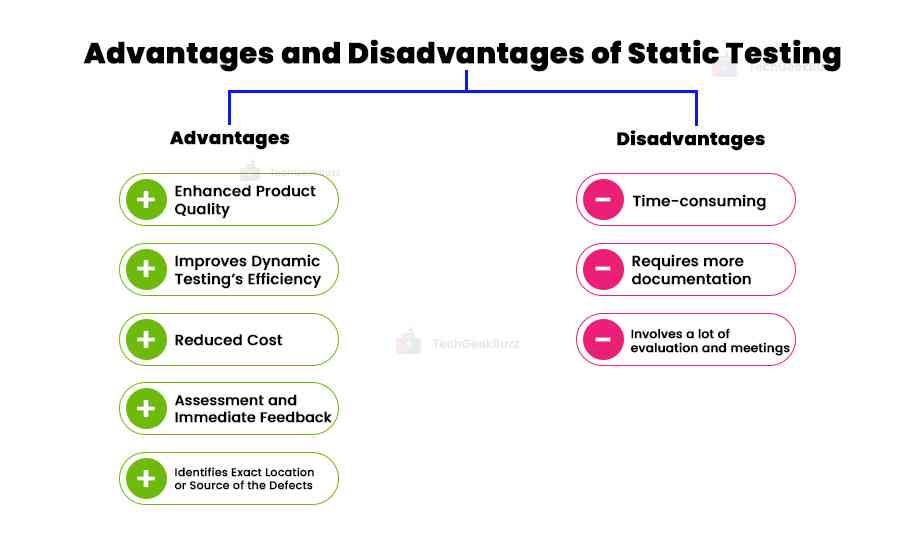
Advantages
- Enhanced Product Quality: As this type of software testing uncovers flaws or errors in the early stages, it significantly improves the overall quality of the software product.
- Improves Dynamic Testing’s Efficiency: As the source code of the software product gets cleaner in static testing, it becomes easier to perform dynamic testing.
- Reduced Cost: This type of software testing helps discover defects in the software product in the early phases, which, in turn, reduces the cost of fixing them at the later stages of SDLC. Not only does it reduce costs but also the effort and time required.
- Assessment and Immediate Feedback: The immediate feedback after the assessment of the software product helps the development team to improve its overall functioning.
- Identifies Exact Location or Source of the Defects: Static testing proves to be an effective method of identifying the source or location of the bugs when compared to dynamic testing.
Disadvantages
- When performed manually, it requires a significant amount of time.
- A few programming languages are compatible with the automated tools that are available for this kind of testing.
- Such tools can only scan the source code and may provide false positives and false negatives.
- It requires more documentation and involves a lot of evaluation and meetings.
Tips To Perform Static Testing Successfully
The following are some helpful tips that will assist you in carrying out this type of testing successfully:
- Concentrate only on the things that actually matter.
- Plan review activities and keep track of them.
- Provide training to participants involved in the testing process.
- Work on resolving issues of people associated with the product.
- Maintain the entire process formally.
- Remove all the delays in test execution, which, in turn, reduces the testing time and cost.
Conclusion
Static testing proves to be very effective in uncovering the defects in the software product in the very early stages of SDLC. This significantly reduces the time and money required to fix those defects in the later stages of development. It detects errors or bugs that dynamic testing cannot. Also, it makes the process of dynamic testing efficient and smooth as it refines the source code.
We hope this article has aided you in gaining enough clarity on static testing. Still, if you have any queries regarding the article, feel free to share them in the comments section below.
People are also reading:
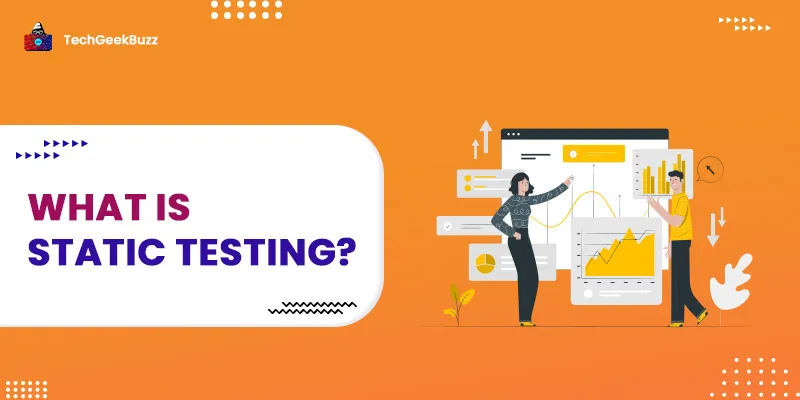

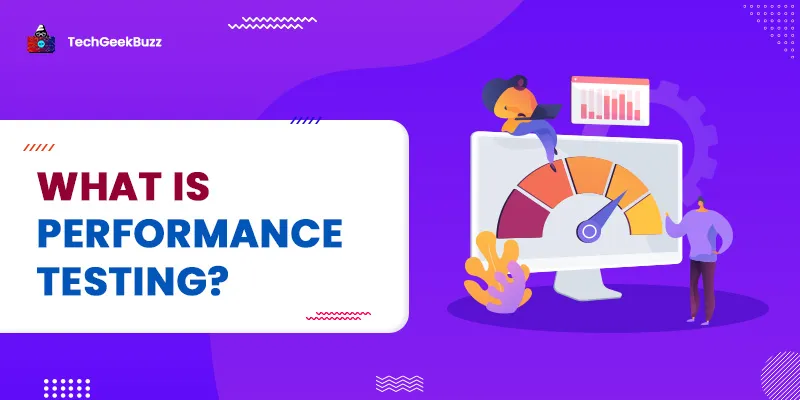
![What is Waterfall Model? [Phases, Pros, & Cons]](/media/new_post_images/Waterfall_Model.webp)
